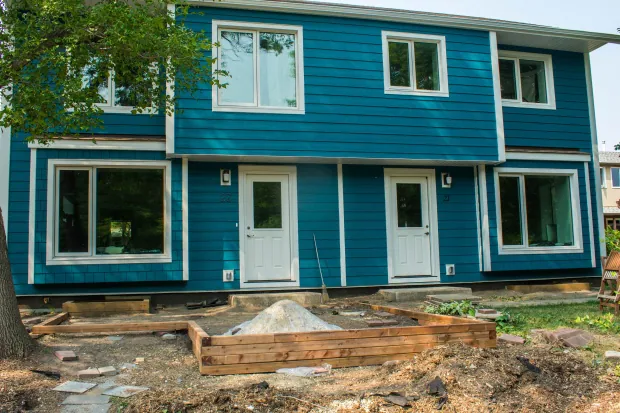Bees buzz between tomato plants, rows of Swiss chard and flowering zucchinis. Defend Alberta Parks signs dapple the Sundance Cooperative Housing property, between porches with lines of pegged drying laundry. Scaffolding surrounds one faded colourful townhouse and construction workers compare measurements.
“I’ve been in construction for 50 years and this is my hardest project,” according to Peter Amerongen, managing partner at Butterwick Projects Ltd.
The project in Edmonton’s Riverdale neighbourhood is based on Energiesprong, a program from the Netherlands that retrofits buildings to net-zero standards with a minimum amount of construction waste.

The co-op’s 59 townhouse units will be encased with high-density foam and the existing structures covered with panels that have been pre-fabricated with new windows and doors. Insulation made from recycled newspapers is then blown into spaces between the new panels and the old building.
The homes will also be powered by solar power and other green energy.
“We’re basically wrapping these buildings in a nice, warm sweater,” Amerongen told CBC Edmonton’s Radio Active in a recent interview.
Residents continue living in their homes throughout the construction, expected to be complete in 2022.
Amerongen said a similar project was done in Ontario in the last few years but Edmonton’s is bigger and more ambitious.
Almost 30 per cent of global carbon emissions come from the energy used to heat, cool and light buildings, according to World Green Building Council. In addition, construction, renovation and demolition waste in Canada makes up about 12 per cent of the solid waste stream.
The housing complex, built in 1978, is a mixed-income affordable community that provides homes to 150 people.
According to the co-op’s website and its residents, the deep energy retrofit made sense.
“If we don’t reduce greenhouse gas emissions, there will not be a livable future,” said Sandy Susut, who has lived in the building for over 40 years.
She hopes this project will become a blueprint for others.
“We can act collectively for future sustainability.”

The federal government has committed to achieving net-zero carbon emissions by 2050.
According to Amerongen, up to 80 per cent of buildings that will be in use in 2050 have already been built today. That means retrofits must become common across Canada to meet emission reduction targets.
“If we don’t get started and take every opportunity to grow as fast as we can, how are we going to look our kids in the eye?”
He said there are more than 14 million dwellings in Canada that need similar retrofits.
“It’s mind-boggling,” said Amerongen.
“That’s a massive new industry waiting to be had. We’ll never have an employment problem again if we do this right.”
Michael Singleton, executive director of Sustainable Buildings Canada, said while green construction projects are taking root in Canada, most of the focus is on new builds.
“But it’s the existing buildings that are really affecting the energy use and greenhouse gases.”

Singleton said Canadian buildings tend to be poorly insulated because utility costs are cheap, especially compared to Europe.
“The way to offset a single-pane window is to put a radiator below it and just have this heat barrier.”
Electricity in Germany is more than twice as expensive as it is in Canada, according to market data company Statista.
The Sundance retrofit project is estimated to cost approximately $10 million, of which $2.5 million is covered by a federal government grant.
